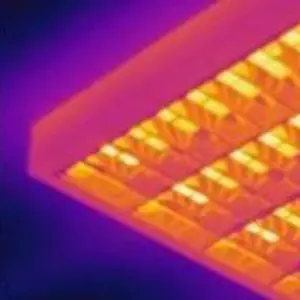You might be surprised to learn that infrared light is used in a variety of different ways, from industrial applications to medical procedures. Here, we’ll explore some of the different ways that infrared light is used in both machines and tools.
What is Infrared Light?
Infrared light is a type of electromagnetic radiation with a wavelength longer than that of visible light, but shorter than that of microwave radiation. Infrared radiation has a range of applications in communications, manufacturing, medicine, and science.
Specific applications for infrared light include:
- Night vision
- Thermography
- Laser surgery
- Infrared saunas
How is Infrared Light Used?
Infrared light falls within the spectrum of energies known as the “infrared region” and can be used for a variety of purposes, including photography, night vision, thermal imaging, and data transmission.
When it comes to infrared photography, a special camera or film is needed that is sensitive to this type of light. In thermal imaging, an infrared camera is used to detect the difference in temperature between objects and their surroundings. This can be helpful for medical purposes (such as detecting tumors) or for industrial uses (such as finding leaks in pipes).
Infrared light can also be used for night vision by amplifying the amount of available light. This is often done with special goggles or lenses that filter out visible light while allowing infrared to pass through. Data transmission using infrared light is common with devices like remote controls and wireless keyboards/mice.
What are the Benefits of Infrared Light?
There are many benefits to using infrared light, including the following:
- It can penetrate through fog and smoke better than visible light, making it ideal for applications such as security and surveillance.
- It can be used to detect objects that are not visible to the naked eye, such as heat signatures.
- It can be used for healing purposes, as it can penetrate through the skin and improve circulation.
- It can be used to dry ink or paint, as the heat will speed up the drying process.
What are the Drawbacks of Infrared Light?
Although infrared light has many benefits, there are also some potential drawbacks to consider. One of the biggest concerns is that infrared light can be harmful to the eyes. Prolonged exposure can lead to damage to the retina and other parts of the eye, so it’s important to wear proper eye protection when working with infrared light sources.
Another concern is that infrared light can cause skin irritation in some people. This is usually only a problem with very intense sources of infrared light, but it’s something to be aware of if you’re going to be working with this type of light on a regular basis.
Finally, infrared light can be a fire hazard. This is because it can easily ignite flammable materials such as paper or fabric. If you’re going to be using infrared light in an area where there is a risk of fire, it’s important to take precautions and make sure that the area is well-ventilated.
What are the Different Types of Infrared Light?
There are three main types of infrared light- near infrared, also called near-IR or NIR; mid-infrared, also called mid-IR or MIR; and far infrared, also called far-IR or FIR.
- Near-infrared waves are closest to visible light on the electromagnetic spectrum and have the most energy, while far-infrared waves have the least energy. Near-infrared light is used in night vision goggles, remote controls, and fiber optic communication.
- Mid-infrared light is used in thermal imaging and some medical procedures.
- Far-infrared light is used in saunas, some medical procedures, and astronomy.
What are the Applications of Infrared Light?
Generally, anything that uses heat will have an application for infrared light! Here are some examples:
- Cooking: Infrared cookers use infrared light to cook food. The light waves heat up the food directly, so the food cooks faster.
- Drying: Infrared dryers work like regular clothes dryers, but they use infrared light instead of hot air to dry clothes.
- Printing: Some printers use infrared light to dry the ink on the paper.
- Heating: Infrared heaters use infrared light to heat up a room. The waves of infrared light make people and objects in the room feel warm.
- Medical therapy: Doctors sometimes use infrared light to treat conditions like pain, arthritis, and inflammation.
How Does Infrared Light Work?
Infrared light is a type of electromagnetic radiation. Electromagnetic radiation is a form of energy that travels through the air and interacts with matter.
Different types of electromagnetic radiation have different wavelengths. The wavelength is the distance between two crests of a wave. Infrared light has a longer wavelength than visible light.
You can think of infrared light as heat waves. You feel infrared light as heat because when it hits your skin, it causes your skin to vibrate. This vibration produces heat. However, infrared light does not just produce heat. It can also be used to create images, send signals, and provide power.
What are the dangers of Infrared Light?
While infrared light is not dangerous to the naked eye, it can be dangerous if you are exposed to it for long periods of time. Infrared light can cause retinal burns, cataracts, and other eye damage. It can also cause skin cancer.
In Closing
Infrared light is used in modern tools and equipment in various industries, including manufacturing and medicine. Just make sure to keep safety in mind whenever you are going to be exposed to high doses of infrared light and wear safety gear.
NEXT UP: How Can You Detect Infrared Light?

